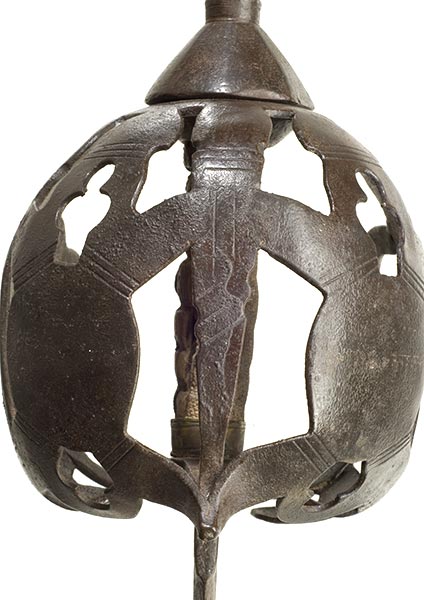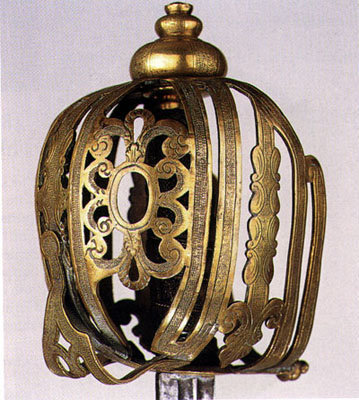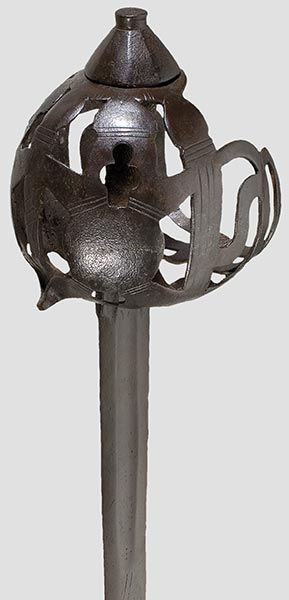Hey guys, these may seem like silly questions, but I've been into baskethilts for some time now and have never come across this info.
1) What is the purpose of the forward guards on Scottish baskethilts?
2) Alot of modern made ribbon hilts seem to have a blued finnish, was this common historically?
3) When a ribbon hilt is described as beak nosed or snouted, what exactly does this mean? I understand the ribbon part, and I assume that the beak nosed / snouted part must have something to do with the baskets shape, but I just don't see it.
4) I've seen examples of baskethilts from Britain, Italy, The Netherlands, Scandinavia, and the Holy Roman Empire, but none from France Spain or Ireland. How popular were baskets in these three countries, did they have native styles, or did they import them from the other countries? I'm thinking probably imports, but I could be wrong.
Thanks in advance.
1: These are often called sword-breakers, although this doesn't imply that they can break a blade, but that if you catch another blade you might, with a twist of your wrist control your opponents blade (that's the theory at least). That many basket hilt types don't have them might hint something to how effective or how often it might occur. And many swords have the forward guards at such an angle it doesn't seem feasible to me.
2: According to the Wallace book many basket hilts were either blackened or browned or japanned (painted with some kind of varnish) to protect them from the humid enviroment of the British isles. If this is particular to ribbon hilts I don't ken.
3: The beak nosed or snouted ribbon hilt is the later type that doesn't have the full quillons but it has been cut short and the saltire bars often is welded to the end of the crossbar. This gives it a beak like appearance or a snout.
4: Can't help you with the other countries, but as far as I've read, the ones found here in Norway were imported from Germany. I remember the portrait of Sir Neil O'Neil of Tyrone, who was killed at the battle of the Boyne, shows him with a basket hilt on his hip. Whether or no it's of local make I can't say. The French did make some basket hilts for one of their Scottish regiments, and I remember seeing one of these belonging to Eljay.
I'm sure some of the more knowledgable members can help you. :)
Cheers,
Henrik
2: According to the Wallace book many basket hilts were either blackened or browned or japanned (painted with some kind of varnish) to protect them from the humid enviroment of the British isles. If this is particular to ribbon hilts I don't ken.
3: The beak nosed or snouted ribbon hilt is the later type that doesn't have the full quillons but it has been cut short and the saltire bars often is welded to the end of the crossbar. This gives it a beak like appearance or a snout.
4: Can't help you with the other countries, but as far as I've read, the ones found here in Norway were imported from Germany. I remember the portrait of Sir Neil O'Neil of Tyrone, who was killed at the battle of the Boyne, shows him with a basket hilt on his hip. Whether or no it's of local make I can't say. The French did make some basket hilts for one of their Scottish regiments, and I remember seeing one of these belonging to Eljay.
I'm sure some of the more knowledgable members can help you. :)
Cheers,
Henrik
1. Agree with Henrik, they seem to be intended for binding the opponents blade, however, many early baskethilts do not have them and on many later basket hilts the forward guards seem impractical for this purpose and mainly decorative
3. the beak is formed by the way the steel basket (which originally is flat) is folded into shape and then welded to the cross bar. see pic below. It is not necessary to form the basket and weld the bars in this manner, not all ribbon hilts have such a "beak nose". Some believe it to be a deliberate construction technique, i.e. the beak has a purpose (either for additional deflection of an opponents blade or to punch forward in close quarters)
4. It depends of course what you call a baskethilt as there are many different types and forms in the 18th century. But as far as full baskets similar in size to the Scottish baskethilts in the 18th century there were full (as opposed to half or 3/4) baskethilts made in Ireland that were slightly unique in style. The most famous being the one below. There were also full baskethilts made in France but I don't have a picture handy (I seem to recall that there is a French made baskethilt in the Royal Armouries collection and will have to check that)
 Attachment: 46.56 KB
Attachment: 46.56 KB

 Attachment: 55.4 KB
Attachment: 55.4 KB

3. the beak is formed by the way the steel basket (which originally is flat) is folded into shape and then welded to the cross bar. see pic below. It is not necessary to form the basket and weld the bars in this manner, not all ribbon hilts have such a "beak nose". Some believe it to be a deliberate construction technique, i.e. the beak has a purpose (either for additional deflection of an opponents blade or to punch forward in close quarters)
4. It depends of course what you call a baskethilt as there are many different types and forms in the 18th century. But as far as full baskets similar in size to the Scottish baskethilts in the 18th century there were full (as opposed to half or 3/4) baskethilts made in Ireland that were slightly unique in style. The most famous being the one below. There were also full baskethilts made in France but I don't have a picture handy (I seem to recall that there is a French made baskethilt in the Royal Armouries collection and will have to check that)


Thanks guys that cleared some things up for me. Thom, if you have it, I'd love to get more info on that Irish baskethilt you posted e.g. which elements make it slightly unique?
| Stephen Curtin wrote: |
| Thanks guys that cleared some things up for me. Thom, if you have it, I'd love to get more info on that Irish baskethilt you posted e.g. which elements make it slightly unique? |
The stepped two piece pommel, the shape of the bars, the shape of the cutouts (no allusions to a St Andrew's cross), and the decorative aspects - particularly the detailed chiseling.
| Thom R. wrote: | ||
The stepped two piece pommel, the shape of the bars, the shape of the cutouts (no allusions to a St Andrew's cross), and the decorative aspects - particularly the detailed chiseling. |
Do you have further info ??? Dating, history, etc.
Jack
The Irish brass baskethilt, was cataloged by Peter Finer in 1995. Don't know who owns it now. My understanding is that it was given a 1740s date based on some offical portraiture of one of the Lord Lieutenants of Ireland in the 1740s (William Cavendish?). there was a thread with better photos on SFI once upon a time, but Mac's links in that thread are all broken now. tr
| Thom R. wrote: |
| The Irish brass baskethilt, was cataloged by Peter Finer in 1995. Don't know who owns it now. My understanding is that it was given a 1740s date based on some offical portraiture of one of the Lord Lieutenants of Ireland in the 1740s (William Cavendish?). there was a thread with better photos on SFI once upon a time, but Mac's links in that thread are all broken now. tr |
Thanks.
Do you have any info on the "plainer hilt" ????
Jack the ribbon hilt I used to illustrate the beak nose construction was a sword that sold at Hermann Historica a couple of years back which looked to be all original. I would have loved to get that one (and tried) but the bidding went way beyond my means!! Given the blade markings it looked to be 1680-1720. Probably pre Georgian but not early 17th c. tr
| Thom R. wrote: |
| Jack the ribbon hilt I used to illustrate the beak nose construction was a sword that sold at Hermann Historica a couple of years back which looked to be all original. I would have loved to get that one (and tried) but the bidding went way beyond my means!! Given the blade markings it looked to be 1680-1720. Probably pre Georgian but not early 17th c. tr |
Is it of "Irish make ????
Jack
| Jack W. Englund wrote: | ||
Is it of "Irish make ???? Jack |
No, that one is presumably Scottish, with a German blade with running wolf mark.
Sometimes people get confused when reading English documents that mention "swerdes with Irish hilts", but you have to understand that in the 16th and 17th centuries, gaelic speaking people in both Ireland and Scotland were both often referred to as "Irish".

Page 1 of 1
You cannot post new topics in this forumYou cannot reply to topics in this forum
You cannot edit your posts in this forum
You cannot delete your posts in this forum
You cannot vote in polls in this forum
You cannot attach files in this forum
You can download files in this forum
All contents © Copyright 2003-2006 myArmoury.com — All rights reserved
Discussion forums powered by phpBB © The phpBB Group
Switch to the Full-featured Version of the forum
Discussion forums powered by phpBB © The phpBB Group
Switch to the Full-featured Version of the forum